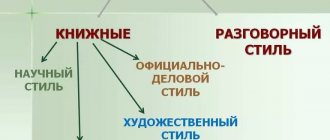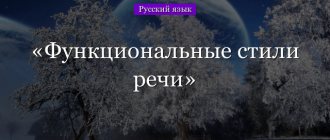History of the style
Scientific language arose due to the fact that various narrow-profile areas of life were rapidly developing. At first it could be compared with an artistic style of speech, but over time it began to differ, acquiring its own characteristic features and characteristics.
In ancient times in Greece, a privileged class of people used a special terminology that ordinary citizens could not perceive correctly. At the same time, experts began to identify the main features of the scientific style of speech. Initially, the terms were used exclusively in Latin, but then all the world's scientists made translations into their native languages.
Over time, the style of the scientific text became precise and concise, which separated it as much as possible from the literary presentation. After all, artistic language introduces significant coloration into the perception of the text, which is unacceptable for the scientific style.
The scientific style of speech and its definition developed rather slowly. The opinions of representatives of science regarding the use of styles were significantly divided. This can be judged by Descartes’ negative statements regarding the works of Galileo. He said that his scientific works contain many artistic means. Kepler was also of this opinion, who believed that Galileo quite often used a literary description of the nature of things.
One of the important stages in the development of the scientific style of speech was the works of Isaac Newton. For a long time they served as a kind of standard of style that everyone tried to adhere to when presenting information.
The scientific style in the Russian state began to take shape only at the beginning of the 18th century. At this historical stage, people writing their own texts or translating began to form their own terminology.
In the second half of the 18th century, the famous scientist Mikhail Lomonosov, together with his followers, gave impetus to the formation of a characteristic scientific type of speech in Russia. Most experts took his works as a basis. The basic scientific terms were finally created only at the end of the 19th century.
Varieties of scientific language
According to modern standards, there are several types of scientific style in the Russian language, which have their own characteristics. These include the following speech styles:
Popular science
This type of text is addressed to those people who do not have special skills and knowledge in any specific area. It is characterized by simplicity of presentation in order to achieve accessibility for the public, but at the same time it retains a sufficient amount of terminology and clarity.
In addition, it is allowed to use such speech forms that evoke emotion in the audience. The purpose of scientific public language is to familiarize people with certain facts or phenomena.
This species also has a subspecies called scientific and artistic. With this presentation, a minimum of special terminology and numerical values are used, and if they exist, then experts try to explain them in detail.
The popular science style is characterized by comparative analysis with ordinary objects, easy reading and perception of information. This text is used in books, magazines and other publications.
Training
It is designed for people studying in educational institutions. The purpose of this style is to introduce pupils and students to the information that is required to acquire certain knowledge in a particular area.
The scientific style and its features in this case consist in the use of many typical examples. This style is characterized by the use of professional terms, a clear division into categories, and smooth transitions from the general to the specific. Such texts can be found in textbooks, manuals, and manuals.
Actually scientific
In this case, the audience is people specializing in the field and scientists. The task of such texts is to describe certain facts, phenomena, patterns, and so on. You can draw your own conclusions in them, but do not color them with special emotionality. An example of this type of scientific style can be found in dissertations, reports, and reviews.
Technical
This type is necessary for highly specialized specialists. The purpose of this style is to describe skills and abilities that were acquired through practical means. It is characterized by a lot of digital, statistical data and technical characteristics.
Fascinating reading of linguistic works
◄ Previous: 2. Euphony Next: 4. Inflectional morphemes ►
Book vocabulary
Book vocabulary
- this is a stylistically colored category of vocabulary: words and expressions characteristic of written (book) language and used in the field of intellectual communication (for example,
crimson, above-mentioned, bowels, rest in Bose)
, contrasted with
colloquial vocabulary
.
The selection of book vocabulary against the background of colloquial vocabulary and interstyle (neutral) vocabulary is due to the stylistic stratification of vocabulary
.
Compared to colloquial vocabulary, book vocabulary is less emotional and expressive (cf. book negative, observe
), book vocabulary includes a significant number of abstract lexemes (
category, hypothesis
), complex words (
inference, import substitution
), terms (
reminiscence, relaxation, synthesize
) ,
borrowings (allusion, approbation),
among which a special layer is made up of
Slavicisms
(
lanits, beneficence
).
Within book vocabulary, separate groups can be distinguished depending on the area of use:
- production and technical vocabulary - words used in the scientific style of speech, as well as in the business style of speech in production instructions, etc. when describing the realities of science and technology ( injector, multi-threaded
),
- official business vocabulary - words and expressions characteristic of business style ( tenant, must
);
- scientific vocabulary - words and expressions characteristic of the scientific style, including a significant number of terms
(
morpheme, verbalize, communication
);
- newspaper and journalistic vocabulary - words and expressions characteristic of the journalistic style, often emotionally charged ( commemoration, fateful
).
Book vocabulary also includes traditional poetic vocabulary.
(cm.).
Book vocabulary also includes folklore (folk-poetic) vocabulary (for example, white oak, once upon a time, good fellow
) - words and expressions typical of the language of folklore, which have their origins in oral folk art, and in modern language are used in fiction for styling.
In explanatory dictionaries
the belonging of lexemes to book vocabulary is indicated by special marks
: book
.,
poet., traditional-poet., folk-poet.
or more detailed:
prof., tech., official.
etc., marks are often used that indicate a specific area of use of the terms:
medical, physical, economics
.
and so on. Within a language, a redistribution of vocabulary between stylistic layers is possible: book words can become commonly used, losing their stylistic markings (argument, crisis
(emerged as a medical term)).
Competent command of book vocabulary indicates a person’s education; correct and appropriate use of book vocabulary allows one to avoid lexical errors.
___________________________
Signs of style
Over time, the scientific style of speech, definition and its features have undergone changes. In modern times, some patterns of such presentation of information have already emerged.
Scientists identify the main features of a scientific style of speech, in connection with which the text should be:
- Logical. This trait is the most basic for using this speech style. Absolutely any coherent statement must have the specified property. But at the same time, scientific language is distinguished by its own logic, which is characterized by emphasis and rigor. All components of information have a strict semantic connection and are presented in a strictly sequential chain, ending with conclusions. This is achieved by using means characteristic of scientific texts, for example, sentences are connected by repeating nouns, which are often combined with demonstrative pronouns. Also, the fact that the information is presented sequentially is indicated by frequently occurring adverbs, introductory words, and conjunctions.
- Accurate. This is another important property that indicates that the text is written in a scientific style. In order to accurately present all the information, words are selected very carefully. However, they are used exclusively in the literal sense. In addition, terminology and special vocabulary are widely used. In such texts you can often find multiple repetitions of key phrases, which is absolutely normal.
- Objective. This trait also applies to scientific style. Such texts present only objective information, for example, they describe the results of experiments and patterns identified during their implementation. All described information requires reliable quantitative and qualitative characteristics.
- Generalized. This important feature necessarily contains any examples of texts in a scientific style. In this regard, specialists often resort to the use of abstract concepts that are almost impossible to imagine, feel, or see.
When presenting scientific information, words that have an abstract meaning are used. Often they use formulas, symbols, provide graphs, make tables, draw diagrams and drawings. All this allows us to most clearly reveal and explain this or that phenomenon.
The scientific style of speech is not characterized by the use of exclamatory statements, as well as one’s own subjective opinion. Therefore, in such texts personal pronouns and verbs in the first person singular are rarely used. Usually they use vaguely personal, impersonal, and definitely personal expressions.
All of the above signs make it possible to understand that the scientific style of speech is not characterized by emotionality or excessive coloration of phenomena.
The text must be logical, accurate, and true. All this is achieved due to the fact that when presenting information, certain rules of a scientific text are adhered to.
Characteristics of scientific information
The scientific style and its features have been formed for a long time and have undergone many changes. Currently, there are three groups of characteristic features of this language:
- lexical;
- morphological;
- syntactic.
Each of these groups reveals specific features that distinguish scientific stylistics of speech from all others. Therefore, it is worth considering them in more detail.
Vocabulary
The scientific style and its vocabulary features are based on the fact that such information has its own immediate task, which is to identify phenomena, objects, name them, and explain them. To achieve this goal, nouns are required first.
The vocabulary of the scientific style has the following characteristic features:
- Words are used exclusively in the literal sense.
- When presenting information, the means by which various images are described in literary works are not used. These include epithets, metaphor, comparison, hyperbole.
- Abstract sentences and terminology are often used.
Features of the scientific style of speech are the identification of three groups of words:
- Stylistically neutral. They are used in any speech styles, which is why they are called generally accepted.
- General scientific. They may contain an example of the scientific style of different areas, rather than just one area.
- Highly specialized. These are words that are characteristic of a specific scientific field.
Morphology
Features of the scientific style of speech include morphology. When disclosing information, the following shall be taken into account:
- In texts it is extremely rare to find the use of verbs in the first or second person singular. In a literary style, this is quite acceptable.
- They use many verbs in the present tense, which are quite similar to verbal nouns. Their use makes it possible to convey a reliable assessment of facts and phenomena quite well.
- The scientific style is not characterized by a feature of presentation in which a large accumulation of adjectives can be found in works. They are rarely used, and they are mostly included in specialized terms. While in a literary text they are used a lot along with epithets and other artistic means.
- When revealing scientific information, parts of speech and their grammatical forms are used slightly differently than in texts of other speech styles.
Morphological features
The language of scientific communication has its own grammatical features. The abstractness and generality of scientific speech are manifested in the peculiarities of the functioning of various grammatical, in particular morphological, units, which is revealed in the choice of categories and forms, as well as the degree of their frequency in the text. Singular forms of nouns are used in the plural: “a wolf is a specialized predatory animal from the class of mammals from the genus of wolves from the canine family”; “The linden begins to bloom at the end of June.” Real and abstract nouns are often used in the plural form: lubricating oils, noise in the radio, great depths.
Naming concepts in scientific style predominates over naming actions, resulting in less use of verbs and more use of nouns. When using verbs, there is a noticeable tendency towards their desemantization, that is, the loss of lexical meaning, which meets the requirement of abstraction and generalization of the scientific style of presentation. This is manifested in the fact that most of the verbs in the scientific style function as connectives: “to be”, “to appear”, “to be called”, “to be considered”, “to become”, “to become”, “to be done”, “to seem”, “ conclude”, “compose”, “possess”, “determine”, “present”, etc. There is a significant group of verbs that act as components of verb-nominal combinations, where the main semantic load falls on the noun naming the action, and the verb performs grammatical role (denoting an action in the broadest sense of the word, conveys the grammatical meaning of mood, person and number): lead - to emergence, to death, to disruption, to emancipation; make - calculations, calculations, observations. The desemantization of the verb is also manifested in the predominance in the scientific text of verbs of broad, abstract semantics: to exist, to occur, to have, to appear, to change, to continue, etc.
Scientific speech is characterized by the use of verb forms with weakened lexico-grammatical meanings of time, person, number, which is confirmed by the synonymy of sentence structures: distillation is carried out - distillation is carried out; you can draw a conclusion - a conclusion is drawn, etc.
Another morphological feature of the scientific style is the use of the present timeless (with a qualitative, indicative meaning), which is necessary to characterize the properties and characteristics of the objects and phenomena under study: “when certain places in the cerebral cortex are irritated, contractions regularly occur”; “carbon constitutes the most important part of a plant.” In the context of scientific speech, the past tense of the verb also acquires a timeless meaning: “N experiments were carried out, in each of which x took on a certain meaning.” According to scientists' observations, the percentage of present tense verbs is three times higher than the percentage of past tense forms, accounting for 67-85% of all verb forms.
The abstractness and generality of scientific speech is manifested in the peculiarities of the use of the verb aspect category: about 80% are imperfective forms, being more abstractly generalized. Few perfective verbs are used in stable phrases in the form of the future tense, which is synonymous with the present timeless: “let's consider...”, “the equation will take the form.” Many imperfective verbs lack paired perfective verbs: “Metals are easy to cut.”
Person forms of the verb and personal pronouns in a scientific style are also used in accordance with the transfer of abstract generalizing meanings. The 2nd person forms and pronouns you, you are practically not used, since they are the most specific; the percentage of 1st person singular forms is small. numbers. The most common in scientific speech are the abstract forms of the 3rd person and the pronouns he, she, it. The pronoun we, in addition to being used in the meaning of the so-called author's we, together with the form of the verb, often expresses the meaning of varying degrees of abstraction and generality in the meaning of “we are the totality” (I and the audience): We come to the result. We can conclude.









